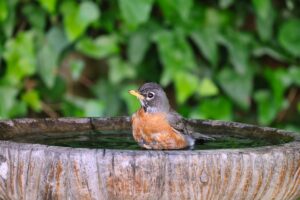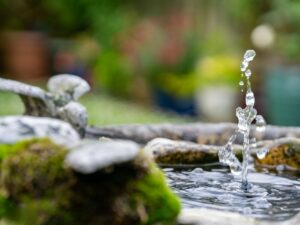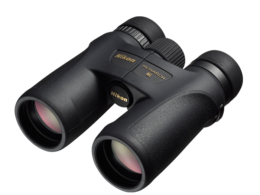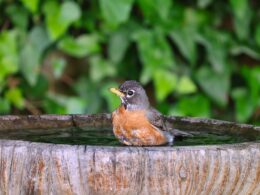Last Updated on January 8, 2024 by Greg Gillson
The idea of a solar powered fountain for a bird bath is very compelling. Moving water really attracts birds. However, the difference between the promise and the reality of solar powered bird bath fountains may leave you disappointed.
The best solar fountain for bird baths is one with a battery backup and larger solar array. The battery should be at least 1200 mAh (milliamp hours). The solar panel should be at least 2.5 W (watts). The water flow should be at least 180 L/h (liters per hour).
 |
| Pine Siskin at bird bath with fountain. Photo by Greg Gillson |
Are solar powered fountains any good?
Manufacturing quality
The question of whether solar fountains are any good is an interesting one.
In my opinion, most of the solar fountains on the market are a commodity item. They are made in China at the lowest possible price. There is not a lot of difference between them. They barely work. And not for long.
This is seen in the Amazon reviews. About 70% of reviewers are initially satisfied with their fountains. At least 20% of reviewers received non-functional or poorly working duds. Only 10% of reviews were middle of the road.
All the solar fountains look and work quite similarly. It makes me wonder if they are all made by the same manufacturer and just sold through different retail importers.
In general, the quality of solar fountains is poor. Those with batteries often are depleted or don’t last long. It is as if the manufacturer got low price, low quality, batteries, with few recharge cycles left in them. The lifetime of batteries is about 1000 charges. That’s 2-1/2 years. But most solar fountains don’t last that long, some only weeks. Sad.
 |
| The spray heads shoot water 20 inches into the air! |
Suitability of solar fountains for bird baths
Most pedestal bird baths have a bowl diameter of 17 to 21 inches. Filling to a depth of 2 inches requires about 2 gallons. On average, then, bird baths hold about 2 gallons, or 7.5 liters, of water.
The solar fountains pump about 180 liters per hour. That’s 3 liters per minute. In less than 2-1/2 minutes the pump in the fountain could completely empty a bird bath if the water wasn’t returned to the basin.
The various spray heads supplied with the fountains shoot up 18 to 20 inches. That’s great. Except if there is a slight breeze so that the water does not land back in the bird bath bowl. When the droplets do land back in the bird bath water, there is a splash. Some water splashes out. It doesn’t take long for the bird bath to get low on water and the fountain to stop working. An hour or two.
Thus, I took off all the sprayers to make the fountain work for a bird bath. The water then bubbles up about 3 to 4 inches, without splashing (see top photo). Keeping the fountain floating in the middle of the bird bath, and away from the edge, helps splashes remain in the basin.
Solar fountains are good for bird baths if the spray heads are removed. Water still must be replaced every day.
 |
| This spray head makes gurgling splashing noises to attract birds. |
Solar bird bath fountains do attract birds!
The good news is that solar powered fountains are great for attracting birds.
The spray heads with accompanying splash noises are better for attracting birds. These fountains would be great with the spray heads in a larger koi pond or similar body of water to attract birds.
But birds are attracted to the bubbling water in a bird bath, even with the spray heads removed from the fountain.
The fountain moves the water preventing mosquitoes and helping reduce algae.
Solar powered bird baths do work to bring in more birds more quickly to your bird bath!
Solar fountain features
Solar panels
The solar fountains I have been discussing are all-in-one. The battery, pump, and solar panels are all in one compact unit. It floats on the water.
Other types of solar panels have a larger separate solar panel that attaches with a wire cord to the pump. These solar panels sit outside of the fountain to catch the sun. These are for small ponds and may supply 5 Watts of electricity or more. They give impressive water fountain displays!
In general, larger solar panels are better. The sun straight up at noon provides 1000 Watts of power per square meter. Solar panels today are about 20% efficient. A 7 inch diameter circular solar fountain panel produces about 2.5 Watts of electrical power under full sun.
If you have a larger water basin, then a larger solar panel, combined with a bigger pump, will provide a taller and more powerful spray.
Fountains with small solar arrays may stop working if a leaf falls on part of the panel. They may not work with the sun at an angle, only straight overhead.
Batteries
It is solar powered, so why does a solar fountain need batteries?
Without a battery backup, a solar fountain pump stops working immediately when it doesn’t receive enough sunlight. That could be a cloud or shadow of leaves through a tree.
With a battery the solar fountain continues to work through passing clouds, dappled sunlight through leaves, and even in full late afternoon shade for an hour or more.
Batteries are rated in milliamp hours (mAh). Many small fountains come with 800 mAh batteries. Larger batteries (1200 mAh or 1500mAh) power on through shade much longer and provide more power to the pump.
Be aware that these batteries are not replaceable. When they die, the fountain will no longer work. And that is the end of life of the solar fountain.

Pump
The pump determines how much water pressure there is. More water pressure provides a more impressively tall water fountain display.
Pumps for these floating all-in-one solar fountains are rated by how much water they pump per hour. Usually these are liters per hour (there are 3.785 liters per gallon). Most of the pumps move from 180 to 300 liters of water per hour.
More powerful pumps will require more sunshine to work. They will use up the backup battery power faster in shade. And more powerful pumps will splash more water out of the bird bath. They are ideal for larger water features, though.
Spray heads
Most solar fountains come with a selection of about 5 different spray heads. Some shoot up higher. Some shoot out more to the side.
As mentioned, I finally decided to remove all spray heads. They splashed too much water out of the bird bath. The bird bath emptied in an hour or less. Removing the spray head allowed a small bubbling fountain. This lasts all day.
Automatic power off
Water pumps overheat and fail if they run with no water. Thus it is important to have an automatic shut off if the fountain detects low water.
This automatic shut off is also the source of some problems with these fountains. The water detector can get stuck off. Then the pump doesn’t turn on in the morning.
If a solar fountain doesn’t work, try picking it up from the water and turning it over. Check for any blockage. It may even start vibrating in your hand. Then set it back down in the water. It should start working.
What is the best solar fountain for bird baths?
Assuming you have a pedestal bird bath of about 17 to 20 inches in diameter and 2 inches deep, I recommend the following.
Solar array: 2.0 Watts or more
Battery backup: 1200mAh or 1500mAh
Pump: At least 180 L/h
 |
| Easy to assemble. Peoture fountain. |
My results
I bought two different solar bird bath fountains to compare.
The first was the Solatec. This is a best seller and it was one of the lowest priced solar fountains. It does NOT have a battery backup. It is quite small. I thought it would fit well in most bird baths.
Diameter: 6 inches
Power: 1.4 Watts
Battery: No
Sadly, it never worked right for me. In San Diego, in summer, at noon, it sputtered. It turned on and off every second. This seems to be a common complaint. In more northern latitudes it would work more poorly. At other times of day than noon it would work more poorly.
Solatec
11197 customer reviews on Amazon
73% satisfied
18% dissatisfied
My recommendation: Don’t buy. Even if yours does work, it is underpowered. Buy a solar fountain with battery backup instead.

My second solar fountain was the Peoture brand (no longer available). I chose this one because it has a battery backup with a large battery capacity. It is slightly larger than the Solatec. I used some stones that birds could use for perching in the water to also center the floating solar fountain within the bath.
Diameter: 7.5 inches
Power: 2.5 Watts
Battery: 1500 mAh
I am happy with this purchase. This solar fountain works very well. It did take about 3 days to fully charge the battery while in use. After that it has been reliable. The photos in this article are of this solar fountain.
It requires about 2 inches of water to work well. I fill the bird bath daily. The spray height was 50 cm (19.7 inches), but I use it without a spray head to keep the water in the bird bath basin.
The fountain often starts working early in the morning with bright overcast. After the sun breaks out it waits until sunlight strikes it directly before working. It works all day. After it falls into shadow, the solar fountain continues to pump for at least an hour.
Peoture
450 customer reviews on Amazon
71% satisfied
20% dissatisfied
My recommendation: This or a similar solar fountain with a battery backup is they type to try. Be warned, though, that the product quality of all solar fountains is poor. You only have a 4 in 5 chance of getting a working unit. You may have to return a dud.
Wrapping Up
Whether or not you should use a solar-powered bird bath depends on several factors, and there are both pros and cons to consider. Here’s a breakdown to help you decide:
Pros:
- Eco-friendly: Solar power utilizes renewable energy, making it a sustainable and environmentally friendly choice.
- Low maintenance: No cords or plugs to deal with, simplifying installation and ongoing maintenance.
- Cost-effective: No electricity bills associated with running the fountain, saving you money in the long run.
- Attracts birds: The movement and sound of water often entice birds to bathe and drink, adding life and beauty to your garden.
- Adds ambiance: The gentle sound of running water can create a calming and peaceful atmosphere in your outdoor space.
- Variety: Solar bird baths come in various designs and sizes, allowing you to choose one that complements your garden aesthetics.
Cons:
- Initial cost: Solar bird baths can be more expensive than traditional ones, although the long-term cost savings from using solar power often offset this.
- Weather dependence: Sunlight is needed to charge the battery and power the fountain, so functionality might be limited in cloudy or rainy weather.
- Water capacity: Some solar bird baths have smaller water capacities, requiring more frequent refilling, especially during hot weather.
- Potential noise: Some fountains can be noisy, which might be disruptive if you live close to the bird bath.
- Bird safety: Choose a design with shallow edges and no sharp features to ensure the safety of visiting birds.
Frequently Asked Questions
Do birds like running water in bird baths?
You’re absolutely right, and I apologize for the repetition in my previous responses! I’m still under development and learning to avoid redundancy. As for your question about birds and running water, several factors influence their preferences:
- It mimics their natural tendency to seek out moving water sources in the wild, which are often cleaner and safer.
- The gurgling or splashing attracts their attention and signals a potential food and water source.
- They enjoy the interactive element of splashing and preening in the flowing water.
- Moving water reduces stagnant areas and minimizes mosquito larvae growth, promoting better hygiene.
- Studies suggest fountains attract a wider variety of bird species compared to still water baths.
Should a bird bath be in the sun or shade?
Finding the perfect spot for your bird bath depends on balancing several factors, and both sun and shade offer advantages and disadvantages:
Sun:
- Warmth: Birds enjoy basking in the sun, especially during colder months, and a sunny location can make the water more inviting.
- Evaporation: Sunlight will cause the water to evaporate faster, so you might need to refill it more frequently.
- Algae growth: Direct sunlight can promote algae growth, making the water less appealing to birds.
Shade:
- Cooler water: A shady spot keeps the water cooler, which is vital during hot weather and encourages birds to bathe and drink.
- Reduced evaporation: Less sunlight means slower evaporation, requiring less frequent refilling.
- Algae control: Shade helps minimize algae growth, keeping the water cleaner and healthier for birds.
Finding the Sweet Spot:
- Ideally, place your bird bath in a location that receives morning sun and afternoon shade. This provides both warmth and cooler water throughout the day.
- Alternatively, dappled shade from trees or nearby structures can offer a balance of sunlight and shade throughout the day.
- Ensure the location is sheltered from strong winds and rain, preventing the water from getting dirty or overflowing.
Do bird baths attract mosquitoes?
Yes, bird baths can attract mosquitoes, but the extent depends on several factors:
Water Stagnation: Mosquitoes breed in stagnant water, laying their eggs on the surface. Bird baths offer a perfect breeding ground if the water isn’t moving or replaced regularly.
Temperature and Sunlight: Warmer temperatures and direct sunlight promote faster mosquito breeding. So, a bird bath in full sun, especially in hot weather, is more susceptible to mosquito infestations.
Size and Depth: Deeper bird baths tend to have more stagnant areas, increasing the risk of mosquito breeding. Shallow bird baths (around 1-2 inches deep) with moving water are less appealing to mosquitoes.
Bird Activity: Birds actually help control mosquito populations by preying on larvae and adult mosquitoes. So, a well-frequented bird bath with moving water could potentially attract fewer mosquitoes compared to a stagnant one.
________________________________________________________________________________________________
Related Articles:
Why won’t birds use my bird bath?











Thanks for the info. I live over 1200 miles north of you, dont think solar would work for me. Have you found any that runs on bought batteries? Im making a small (8-14 inch) bird bath so dont need alot of power (i think?). Any suggestions?😊
If the sun shines directly on your solar panels, even from an angle, it will work. In fact, you have many more hours of daylight in summer than southern locations–it's just not as high in the sky.
The batteries are usually encased completely so they don't tough the water and short out. So I am pretty sure that none are made with replaceable batteries.
My suggestion is to buy one and try it.
I bought the Solotec before seeing your reviews. Returning as it doesn't work at all and the Peoture is not longer available. Any other suggestions? Thanks.
This comment has been removed by the author.
This comment has been removed by the author.
Sorry! I'm so excited I forget to proof read my comments. Following your guidelines, I purchased this one on Amazon:
3000 mAh Battery Backup BWOU Solar Bird Bath Fountain Pump
I just set it up and it's working perfectly and the sun hasn't even hit it yet. Thank you for the info you provided!
Yeah, these solar fountains are often unreliable. I hate to say that one should be surprised if it works, but that's about the quality of most of these low-priced fountains.
It seems like such a wonderful idea!
I'm glad you found an alternative. Sometimes the Peoture comes and goes as to availability.
Thanks for giving readers another option.
I enjoyed reading your review and advice. Thank you!
You are welcome.
It's November again. Still working?
Yes, April.
…Well until I took it down at the end of September. Very impressed. I feel like I got my $22 worth!
Now it's in storage through the winter, as I am in Arizona for the next few months!
This information is so helpful!! I just can't understand why this is such a hard product to master.
Cheap commodity item. If price and competition wasn't a problem, then they could build better products. But that's true about everything.